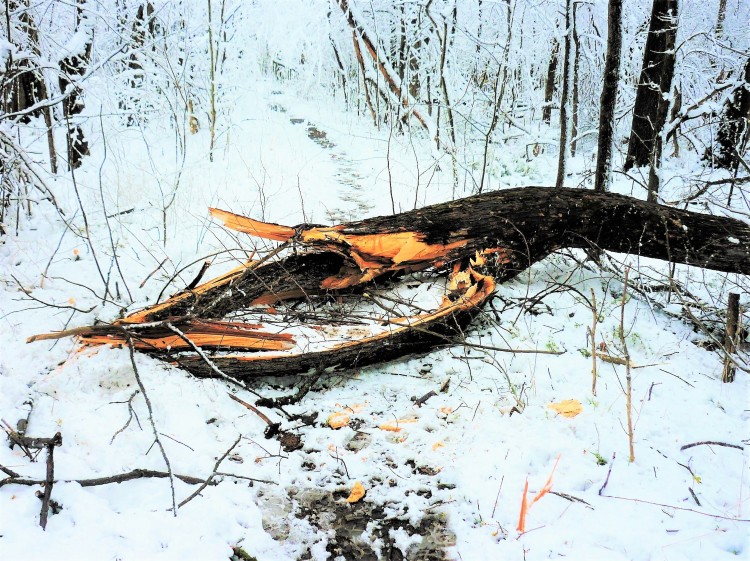
Have you ever wondered why plants have such varied architecture? Among the selection pressures shaping the planet’s flora, heavy burdens of snow have been major. This past week’s spring surprise, though very brief, showed how differently the plants in our forest handle this kind of stress.
Six inches of dense heavy snow falling within a few hours is not a common occurrence in the Ohio River Valley. Already wet with rain, even the smallest of branches accumulated a uniquely heavy burden. How well the plants of this forest handled the weight has a lot to do with their sizes and shapes.

Snow cover was particularly heavy on the larger, densely branchy Spicebush shrubs. A few of the male Spicebush were already blooming, the others thick with buds ready to burst. Many large branches were bent nearly to the ground, but surprisingly almost none snapped, showing a high degree of flexibility. This is a good adaptation for an understory shrub that may have trees and limbs falling on it from time to time.

Some smaller trees, particularly spindly light-starved Hackberries, were also weighted nearly to the ground. I’ll be curious to see if this brief bending exercise has any lasting effects.

The flora of northern and mountain forests consists largely of snow-adapted conifers, whose drooping aspect and slippery needles allow them to cope with a heavy load. Our tall branchy deciduous trees, many leaning already, can’t shed snow so easily. The trees in the pic above were bent surprisingly low, and the stress was quick to target areas of weakness and decay. As I was taking these pictures, the sharp crack of limbs snapping made me more jumpy and vigilant than usual!

Some forest giants, like the last declining American Elms, lost huge chunks of themselves.

For anyone who’s thinking climate change means earlier, warmer springs – think again. More likely it means greater unpredictability, with a wider range of possible weather conditions and more extreme weather events. These stresses will shape the future of life rather quickly, as selection pressures “weed out” the less adaptable. Yet another reason to preserve and restore as much diversity as possible.
Marianna metcalf
Again, a wonderful post. Glad you were not hit by that heavy branch
LikeLiked by 1 person
oneforestfragment
Me too – I have seen it almost happen to other people!
LikeLiked by 1 person
Deany C.
On Wednesday I heard the sound of large braches breaking and falling to the grown. I went out and gently removed the snow from pine trees and butterfly bushes. Thank you for the great post! I am always learning from your post.
LikeLiked by 1 person
oneforestfragment
Thanks Deany! It’s definitely shown us which trees are vulnerable.
LikeLiked by 1 person
tonytomeo
Snow is so rare here that the trees are not adapted to it. When it does snow, trees break. Tall redwoods and firs drop big limbs.
LikeLiked by 2 people
oneforestfragment
You don’t see really big trees with big limbs in snow country. Here, all the big Saucer Magnolias in bloom got “snow pruned”.
LikeLiked by 2 people
tonytomeo
While in Oklahoma, I noticed that all the blackjack oaks in our neighborhood had been ‘tornado pruned’. They were all similar post like trunks with small twiggy stems growing off of them. I noticed that pattern in other places, although collectively, the trees were quite pretty.
LikeLiked by 1 person
oneforestfragment
That’s very interesting; something I’ll have to watch for when in tornado country. Sounds like tornado prone climates also exert a unique kind of selective pressure on trees.
LikeLiked by 2 people
tonytomeo
It is not the climate that does it so much as the tornadoes. They strip everything up vertically from the trunks.
LikeLiked by 1 person
oneforestfragment
Yes, I meant over long periods of time some species of trees may be more adapted to grow in areas with high winds and regular tornado activity. Guess this would apply to hurricanes too – apparently Sand Live Oak, Southern Magnolia, Live Oak and Bald Cypress can withstand hurricanes better.
LikeLiked by 2 people
tonytomeo
I did not know that, but it makes sense that trees that live with hurricanes would be more adapted to them. I would not expect the same in regard to tornadoes, because tornadoes are relatively rare. I mean, a magnolia on the coast might experience several hurricanes during its lifetime, but a blackjack oak may never experience a tornado. Although tornadoes are more common, they affect relatively small areas, so the likelihood of encountering one is relatively slim.
LikeLiked by 1 person
oneforestfragment
Good point! Tornados are certainly less common, and their paths are often narrow and erratic. The topic of plant architecture is an interesting field of study: I hope to work my way through some of the research, such as this article: https://pdfs.semanticscholar.org/e762/d58d0b9e86e27857ecf5098d0cdb00645286.pdf
LikeLiked by 2 people
Michael Smith
I noticed several damaged trees on Trevilian Way. Our maple had damage for the third time in 10 years. I wonder how many trees we lost during this storm.
LikeLiked by 1 person
oneforestfragment
In a way it’s good to have weak or stressed limbs pruned off like this, rather than falling at some random time.
LikeLiked by 1 person